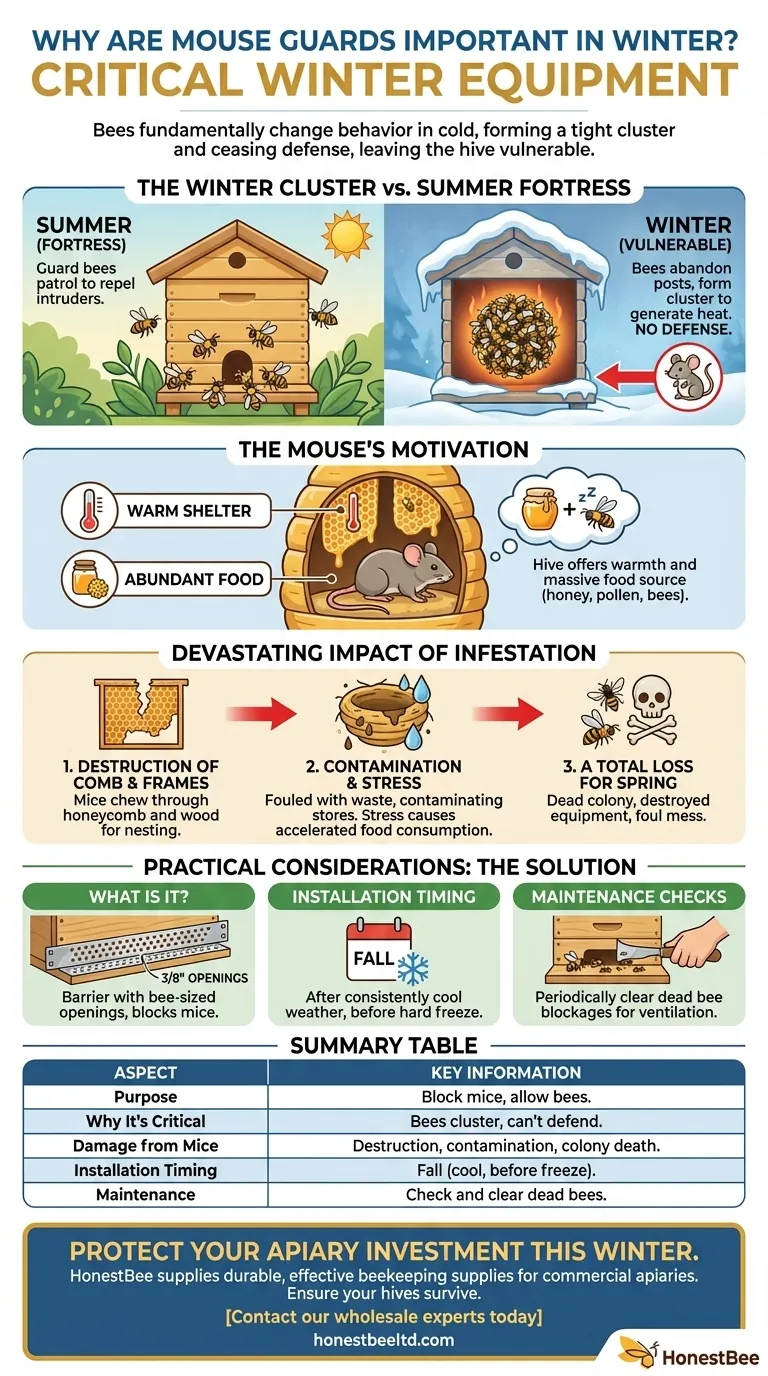In short, mouse guards are critical winter equipment because honeybees fundamentally change their behavior in the cold. They form a tight, heat-generating cluster and cease to patrol their hive, leaving it completely undefended against mice seeking warmth and food.
A beehive in winter is a perfect shelter for a mouse, offering warmth and abundant food. Because the bee colony is clustered together and unable to defend itself, a simple mouse guard is the only thing standing between the colony's survival and its total destruction by rodents.

Why a Winter Hive is Uniquely Vulnerable
To understand the importance of a mouse guard, you first have to understand the stark contrast between a hive in summer and a hive in winter.
The Winter Cluster
In warm weather, a hive is a fortress, with guard bees constantly patrolling the entrance to repel any intruder.
As temperatures drop, the bees abandon their posts and form a winter cluster around the queen. Their sole focus becomes shivering their flight muscles to generate heat, keeping the center of the cluster alive. They cannot and will not leave this cluster to chase out pests.
The Mouse's Motivation
A beehive is an irresistible winter destination for a mouse. It provides a warm, insulated cavity protected from the elements.
More importantly, it contains a massive food source in the form of honey, pollen, and even the bees themselves. To a mouse, a defenseless hive is the ideal place to build a nest and wait out the cold.
The Devastating Impact of a Mouse Infestation
A mouse inside a winter hive is not a harmless guest. The damage they cause over a few months is almost always a fatal blow to the colony.
Destruction of Comb and Frames
Mice will chew through honeycomb and wooden frames to create a nesting area. They destroy the delicate wax structure that the bees spend immense energy building.
Contamination and Stress
The nest area will be fouled with urine and droppings, contaminating stored honey and pollen. The constant presence, noise, and smell of the mouse cause significant stress to the clustered bees, forcing them to consume their winter honey stores at an accelerated rate.
A Total Loss for Spring
By spring, a beekeeper opening a mouse-infested hive will find destroyed frames, a foul mess, and often a dead colony. The bees will not clean up the contamination, rendering the equipment a complete loss.
Practical Considerations for Mouse Guards
Simply installing a mouse guard is the first step. Proper timing and maintenance are essential for it to be effective.
What is a Mouse Guard?
A mouse guard is simply a barrier, typically a strip of metal or wood, placed over the hive entrance. It has openings that are large enough for a bee to pass through (around 3/8 inch or 9.5mm) but too small for a mouse to squeeze through.
When to Install
You should install mouse guards in the fall after the weather has turned consistently cool, but before the first hard freeze. This ensures the drones (larger male bees) have been expelled for the winter and won't get trapped inside.
The Need for Periodic Checks
During winter, dead bees can accumulate behind the mouse guard and block the entrance. This can be catastrophic, as it prevents ventilation and traps the bees inside during rare warm days when they might attempt a "cleansing flight." A quick check to clear the entrance is vital.
Making the Right Choice for Your Colony
Using a mouse guard isn't a suggestion; it's a fundamental part of responsible winter hive management.
- If your primary focus is colony survival: View a mouse guard as an essential, non-negotiable piece of winter equipment, just like ensuring the hive has enough food.
- If your primary focus is a strong start in spring: Preventing a mouse infestation ensures your hive emerges from winter healthy and ready to build up, rather than weakened or already dead.
A simple mouse guard is one of the most effective and low-cost insurance policies you can implement for your bees' winter survival.
Summary Table:
| Aspect | Key Information |
|---|---|
| Purpose | To block hive entrance from mice while allowing bee passage. |
| Why It's Critical | Bees form a winter cluster and cannot defend the hive, leaving it vulnerable. |
| Damage from Mice | Destruction of comb, contamination, stress on bees, and potential colony death. |
| Installation Timing | In fall, after consistent cool weather but before the first hard freeze. |
| Maintenance | Periodically check for and clear dead bees that may block the entrance. |
Protect your apiary investment this winter. A mouse guard is essential, low-cost insurance for your colonies. At HONESTBEE, we supply durable, effective beekeeping supplies and equipment to commercial apiaries and distributors. Ensure your hives survive and thrive into spring. Contact our wholesale experts today to secure your winter equipment.
Visual Guide

Related Products
- Professional Plastic Queen Excluder for Modern Beekeeping
- Metal Queen Bee Excluder for Beekeeping
- Professional Engraved Round Hive Number Tags for Beekeeping
- High Performance Plastic Queen Excluder for Beekeeping and Apiary Management
- Professional Bamboo Queen Isolation Cage
People Also Ask
- How do queen excluders work in terms of spacing and bee movement? A Guide to Precision Hive Management
- What is the purpose of a queen excluder when adding a super? Streamline Your Honey Harvest
- What are the pros of using queen excluders? Boost Honey Production & Hive Efficiency
- What is the role of a queen excluder when adding a super? Ensure Brood-Free Honey Harvests
- What are the main advantages of using a queen excluder in beekeeping? Simplify Hive Management & Harvest



















